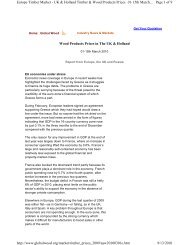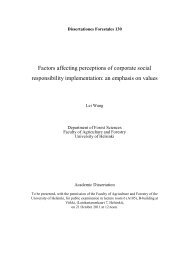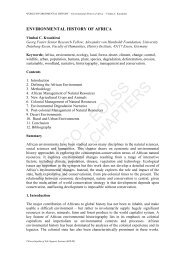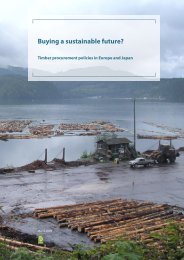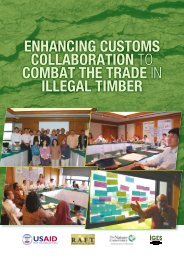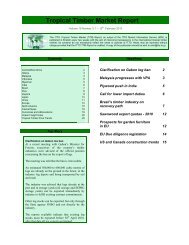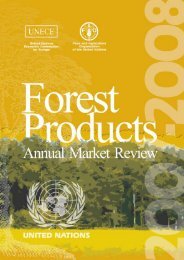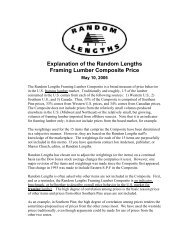ICT and e-Business in the Pulp, Paper and Paper ... - empirica
ICT and e-Business in the Pulp, Paper and Paper ... - empirica
ICT and e-Business in the Pulp, Paper and Paper ... - empirica
Create successful ePaper yourself
Turn your PDF publications into a flip-book with our unique Google optimized e-Paper software.
<strong>Pulp</strong>, paper <strong>and</strong> paper products<br />
technology change" (2005, p. 2). This is quite <strong>in</strong> contrast to <strong>the</strong> op<strong>in</strong>ion expressed by<br />
paper manufacturer Mayr-Melnhof Karton AG (see above).<br />
This particular example may help to expla<strong>in</strong> <strong>the</strong> apparently different assessments of how<br />
'easy' or 'difficult' it is for a company to <strong>in</strong>troduce RFID <strong>in</strong> its operations. To a large extent,<br />
<strong>the</strong> <strong>in</strong>novation capacity depends on <strong>the</strong> overall IT capability of a company. A large player,<br />
whose <strong>in</strong>formation management is well embedded <strong>in</strong> <strong>the</strong> overall company strategy <strong>and</strong><br />
where highly sophisticated systems are already <strong>in</strong> place, is probably well prepared to<br />
implement RFID at any time. For a small company, however, which cannot draw on<br />
comparable e-skills <strong>and</strong> resources, this is certa<strong>in</strong>ly more of a challenge <strong>and</strong> may need<br />
more <strong>in</strong>-advance plann<strong>in</strong>g. Thus, <strong>the</strong>ir risk is also higher.<br />
Strategic position<strong>in</strong>g <strong>and</strong> RFID adoption<br />
It appears that <strong>the</strong> decision whe<strong>the</strong>r to adopt now or later is closely l<strong>in</strong>ked to overall firm<br />
strategy. Companies with a cost leader strategy (cf. Porter 1980) may be dis<strong>in</strong>cl<strong>in</strong>ed to<br />
adopt RFID at this po<strong>in</strong>t, if <strong>the</strong>y are not forced to do so by customers. Firms with a<br />
differentiation strategy, on <strong>the</strong> o<strong>the</strong>r h<strong>and</strong>, <strong>in</strong> particular if <strong>the</strong>y focus on 'cutt<strong>in</strong>g-edge'<br />
supply cha<strong>in</strong> management, are much more likely to see RFID as a useful vehicle to<br />
underl<strong>in</strong>e <strong>the</strong>ir strategic position<strong>in</strong>g.<br />
The case study on Stora Enso (Section 4.1), which positions itself as an <strong>in</strong>novative<br />
company with "a world-class supply cha<strong>in</strong> <strong>in</strong>tegration strategy", is a good example for <strong>the</strong><br />
latter. Aligned with its claim <strong>and</strong> strategy, <strong>the</strong> company currently pilots RFID enabled<br />
possibilities as part of its "PackAgent" solution, toge<strong>the</strong>r with Orion Pharma (see case<br />
study). In contrast, Mayr-Melnhof Karton AG is an example of a company that positions<br />
itself as a cost leader <strong>in</strong> produc<strong>in</strong>g cardboard <strong>and</strong> related packag<strong>in</strong>g solutions. The<br />
company does not see RFID as a tool to save costs at this po<strong>in</strong>t of time. Thus, as<br />
outl<strong>in</strong>ed above <strong>and</strong> <strong>in</strong> l<strong>in</strong>e with its strategy, <strong>the</strong> decision is to wait until <strong>the</strong> technology is<br />
even more mature <strong>and</strong> less costly. 94<br />
In <strong>the</strong> USA, a majority of firms is conv<strong>in</strong>ced that RFID matters for <strong>the</strong>ir bus<strong>in</strong>ess. In a<br />
survey among US companies conducted <strong>in</strong> 2005 by Bear<strong>in</strong>gPo<strong>in</strong>t, three out of five<br />
respondents regarded RFID as “important” or “very important” to <strong>the</strong>ir organisation’s<br />
strategy. 95 The case study on International <strong>Paper</strong> illustrates that RFID certa<strong>in</strong>ly holds an<br />
attractive promise for P&P companies to <strong>in</strong>crease efficiency, but it also shows <strong>the</strong><br />
challenges that are <strong>in</strong>volved, even for such large players, for example with regard to <strong>the</strong><br />
impact on bus<strong>in</strong>ess processes <strong>and</strong> rout<strong>in</strong>es.<br />
<strong>Paper</strong> production: focus on warehouse / <strong>in</strong>ventory management<br />
A key application area for RFID systems <strong>in</strong> pulp <strong>and</strong> paper production, as <strong>in</strong> o<strong>the</strong>r<br />
manufactur<strong>in</strong>g <strong>in</strong>dustries, is warehouse management. The efficiency <strong>and</strong> accuracy of<br />
order fulfilment is closely related to <strong>the</strong> efficiency of warehous<strong>in</strong>g activities. As RFID<br />
systems promise to support <strong>the</strong> company <strong>in</strong> its warehouse management, this is directly<br />
l<strong>in</strong>ked to <strong>the</strong> quality of customer service <strong>in</strong> terms of order<strong>in</strong>g <strong>and</strong> delivery processes.<br />
94<br />
95<br />
Interview with Erasmus Pachta, Manager Electronic Solutions & Services, on 27 March 2006<br />
See: "Beyond Compliance: The Future Promise of RFID", White <strong>Paper</strong> by Bear<strong>in</strong>gPo<strong>in</strong>t,<br />
published <strong>in</strong> May 2005, p. 3. Available at www.rfidjournal.com<br />
139



